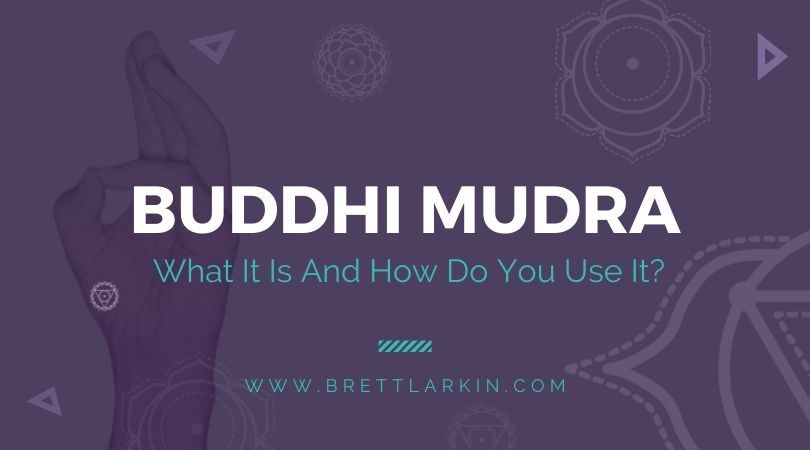
If you’ve ever found yourself with racing thoughts, unable to concentrate, off in your yoga practice, or fidgeting in meditation, you may wonder what you can do to bring more balance to the body and mind. Buddhi mudra can help!
Often, we can use the physical body to help or bring forth intuitive communication to the mind. In yoga class, teachers often use mudras, the Sanskrit word for hand gestures. However, you can use mudras in other parts of your life too.
The popular image associated with meditation is of someone sitting cross-legged with the backs of their hands resting on their knees taking gyan mudra. But there are many other mudras one can take to follow different intentions and heal different areas of the body or life.
To create a mudra, you use your hands and fingers, which act as an energy map to different areas of the body, similar to how different parts of the feet work in reflexology.
Each finger represents a different element in the body:
- Thumb — fire element
- Middle finger — space element
- Index finger — air element
- Ring finger — earth element
- Little finger — water element
The Buddhi Mudra is a wonderful mudra to help clear the mind during meditation, your yoga practice, or any time you want to tap into inner knowledge.
What Does Buddhi Mudra Mean?
Buddhi Mudra is a hasta (the Sanskrit word for hand) gesture, meant to improve mental clarity and balance the water element within the body.
Buddhi means intellect and mudra means seal. Together, they represent the seal of mental clarity. It is also known as the Jal vardhak mudra, named after the Hindu god of water.
In Sanskrit, Jal means water and vardhak means enhance. Knowing that the thumb represents fire and the little finger represents water, bringing the tip of the thumb and the tip of the pinky finger to touch with light pressure symbolizes access to intuition.
Benefits of the Buddhi Mudra – Mental Clarity
Known as the seal of mental clarity, Buddhi Mudra is one of the therapeutic mudras thought to bring forth intuitive energy. It may seem like a simple yoga hand technique but many believe it also has healing properties.
The belief is that this mudra helps to develop psychic energy, which brings you closer to divine nature. Since Buddhi Mudra balances the water element, when there is a lack of water in the body, doing this mudra can help with ailments in the body.

There are also energetic benefits, where the fingers act as a conduit to inner knowledge.
Here are some more direct benefits from the hand posture:
- Improves some skin disorders, such as psoriasis and eczema
- Helps bladder and kidney-related issues
- Can help indigestion, constipation, and other digestive issues
- Addresses disorders related to the blood, such as anemia
- Improves mental clarity
- Removes obstacles such as a busy mind
- Boosts mindfulness
- Aids in psychic development, psychic abilities, and mental powers
How to Do the Buddhi Mudra
To do Buddhi mudra, you use two fingers to balance the water element. Let’s go through the hand posture:
- Hold your hands out, palms facing up
- Gently allow the pads of your pinky finger and thumb to touch
- The other three fingers remain comfortably extended
- If the ring fingers, index fingers, and middle fingers do not easily stay together, change the hand position so they gently come closer to the seal you’ve created
When you bring the tip of the little finger to the thumb, think of it as water extinguishing fire, or bringing balance to the flames. Practicing buddhi mudra in seated meditation is an easy way to focus your intentions and clear the mind. Try my 10-minute beginner-friendly meditation and see for yourself!
When to Do the Buddhi Mudra
Based on the kundalini yoga tradition performing mudras and tapping into their healing energy represents divine nature. To determine which mudra or hand gesture to practice, it’s important to understand your state of mind and how you’re feeling. For example, if you want to energize the solar plexus chakra, you’d want to practice Rudra mudra. However, if you want to balance all energies, prana mudra would be better.
Surya mudra and Varuna mudra have similar healing benefits to Buddhi mudra. You might choose to alternate between them throughout the day during a time when you need extra mental clarity, or at the beginning or end of your kundalini yoga practice.
To gain the most benefits out of this gesture, Buddhi mudra can be practiced for 15-20 minutes, one to three times a day. When doing a mudra practice on its own, it can be nice to seal the practice by placing the left hand over your heart center and the right hand over your belly for a grounding moment.
Learning about the different types of mudras and when to do them can enhance your yoga practice and create wonderful benefits in your life. I look forward to hearing about your experience with Buddhi mudra.
Experience 3 Training Videos from Inside My 200-Hour Online YTT

YOU MIGHT ALSO LIKE
- Trauma-Informed Kundalini Yoga: A Heart-Centered Approach to Healing
- Harnessing the Power of Kundalini Divine Feminine for Transformation
- Kundalini for Feminine Energy: Ignite Your Creative Power and Passion
- Mastering the Sufi Grind: Benefits and Techniques for All Levels
- Kundalini Yoga for Chakras: An Uplifted Guide to Energy Balance
- Discover the Benefits of the Gobinday Mukunday Mantra for Well-Being
- Nabhi Kriya: Ignite Your Inner Fire and Personal Power
- Ek Ong Kar Sat Gur Prasad: Kundalini Mantra For Manifestation
- Tantric Har Chant: How It Fuels Prosperity and Inner Power
- Powerful Mantra for Protection Against Negative Energy and Harm
- The Power of Humee Hum Brahm Hum Mantra for Connection and Healing
- The Sa Re Sa Sa Mantra: Connecting Breath, Light, and Creativity
- What Is The Ajai Alai Mantra In Kundalini Yoga?
- What Is Sat Nam Rasayan? How And When To Practice
- The Meaning Of Ang Sang Wahe Guru Mantra in Kundalini Yoga
Learn how to do 11 of the most popular yoga poses correctly. Free video + PDF download.










